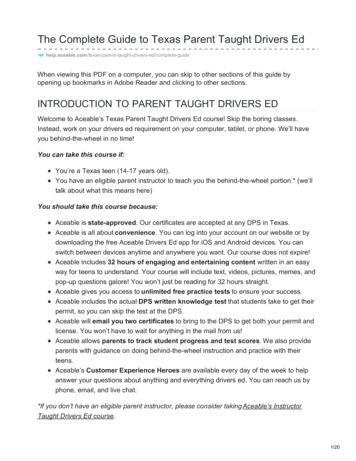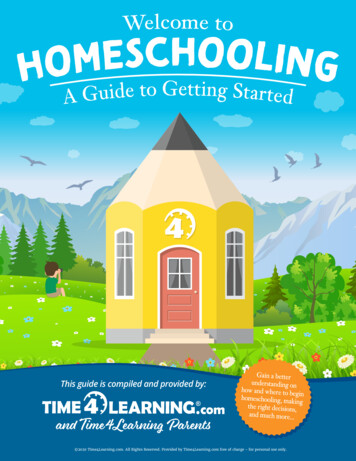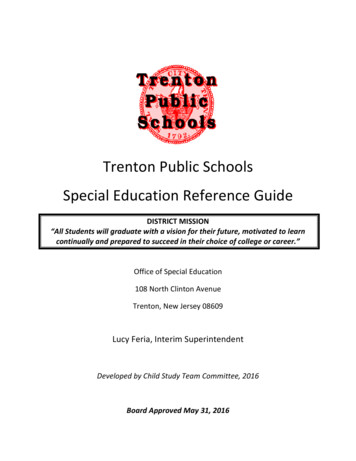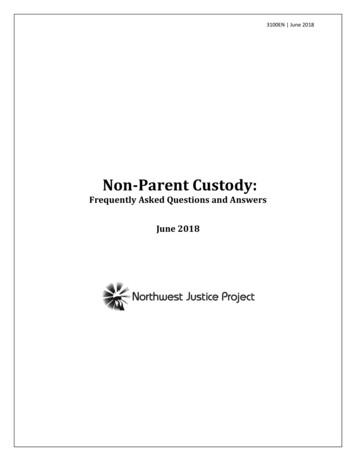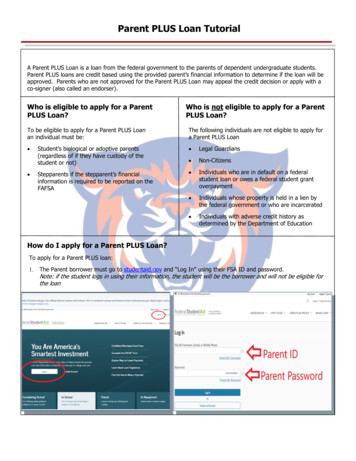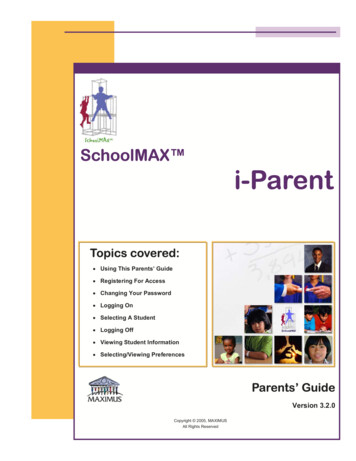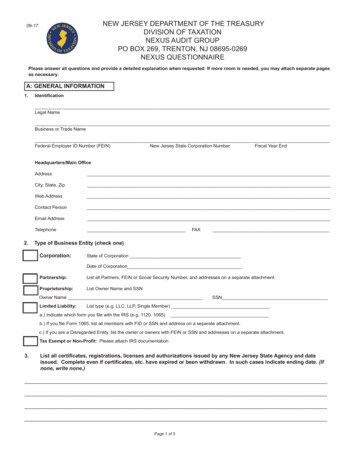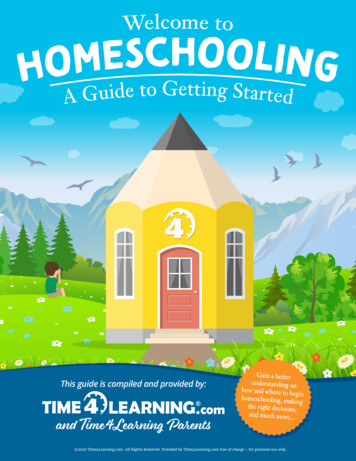
Transcription
This guide is compiled and provided by:and Time4Learning Parents 2020 Time4Learning.com. All Rights Reserved. Provided by Time4Learning.com free of charge - for personal use only.
Page 2Welcome to Homeschooling GuideTABLE OF CONTENTSIntroduction from the Time4Learning Founder .3The Seven Steps to Start Homeschooling .51. Compliance with State Laws .82. Get Ready Deschool! .93. Pick a Curriculum and Get Started .114. Get Social. Learn From Others .145. Layer in Tutors, Supplements, and Support .166. Dream Big, Passion Projects .187. Enjoy the Journey .19Frequently Asked Questions .21Homeschooling Glossary .23Information on Time4learning .26 2020 Time4Learning.com. All Rights Reserved. Provided by Time4Learning.com free of charge - for personal use only.
Page 3Welcome to Homeschooling GuideWelcome,I’m John, the founder andpresident of Time4Learning.The fact that you are readingthis little guide probablymeans you are considering, orhave started, homeschooling.I’d like to welcome you andshare some advice that wehave collected from thehomeschooling families that have come before you.Due to the pandemic, many of you are turning tohomeschooling out of desperation. You might befleeing the inflexibility of school-from-home whichdoesn’t work for your family; or your childrenmight be suffering or not learning due to theimprovised structure of school-from-home; or yourschool might be opening and you are not ready torun the health risks that this involves, and so youare turning to homeschooling.You might be surprised to learn that you actuallyhave a lot in common with existing homeschoolers.In many cases, they abruptly switched tohomeschooling in the middle of a school year.Like you, they felt that they were left with nochoice when it came to their children’s education.Although they intended for their children to go totraditional school from PreK all the way to highschool graduation, something, somewhere alongthe way didn’t work out as planned. To learn moreabout this, try googling: accidental homeschoolers.Let me tell you that homeschooling will, in manyways, be easier than you may think. Reading andfollowing this guide is key. It embeds the wisdomof hundreds of homeschoolers who took harderroutes and have come together to write this book sothat it’s easier for today’s new homeschoolers.In fact, this guide will turn out to be simpler thanyou think. The main section of the guide is only 12pages and could be read in an hour. The secondhalf of this 25-page guide consists of lists, FAQs,and a Glossary at the end which, while useful, areprovided more as reference.Many parents who consider homeschoolingare comforted to know that homeschooling is asurprisingly large movement in the U.S. At thestart of 2020, one in 25 to 30 K12 students in theUSA was being homeschooled. It’s been trendingfor decades and that was before the pandemic.Many of these students are homeschooled foronly three or five years. But the overall shift is forincreasing numbers of students to have some yearsof homeschooling. And while homeschooling usedto be a pioneering or even pirate activity in whichsystems and resources were hard to find, in themodern era, there are plenty of modern educationalmaterials available at reasonable costs that do muchof the heavy lifting for homeschooling parents.Here’s a question:What’s the hardest partabout homeschooling?the Answer:Staying home!It turns out that everyafternoon in almostevery communityacross the country, thereare homeschool field trips,get-togethers, study-groups,support groups, co-ops, andhomeschool classes. There’sso much going on, it’s hard to stay home. Mypoint is that while there is a common myth thathomeschooling is isolating, the opposite is actuallytrue. There is an enormous amount of socialinteraction in the homeschool community. Yourchoice will be to select which groups and howmuch to participate. Of course, the pandemic hasaffected everybody and many groups have split intosubgroups. A basic rule however is that homeschoolgroups tend to be smaller than the public schoolsso there’s more room to set up reasonably safe 2020 Time4Learning.com. All Rights Reserved. Provided by Time4Learning.com free of charge - for personal use only.
Page 4Welcome to Homeschooling Guidepandemic groups.While you may be turning to homeschooling toflee or solve some acute problems, let me tell youthat you are turning down a path which will openyour eyes and many doors. As a family in panicmode (as many are), turning to homeschooling as a“last resort”, you aren’t expecting the education foryour children to be superior. You aren’t expectingto rapidly see your children mature and develop.You aren’t expecting to find that there is a betterlifestyle so easily available.do the best thing for your family so this guide ismeant as a starter’s guide. This is a general purposeguide which will point you towards resources fortopics such as how to best serve your special needschildren, the laws and resources in each state, andall the different methods and resources and groupsthat you might eventually want to know about.I’ll end this intro by sharing three observationsthat I’ve made from talking to thousands ofhomeschool moms over the last 15 years.1.Almost every family finds the decision tohomeschool to be a difficult one. Directing yourchildren’s education is a serious responsibility forparents. And it’s a big, often unexpected, lifestylechange for the family. Rarely is the decision tohomeschool easily made.2.Almost every decision to homeschool is madeon a provisional basis. Let’s homeschool for thissemester and then we’ll see. OK, we’ll try a second yearand see how it goes.3.But be aware: these are real possibilities. Ithappens over and over again, even in the mostanxious, confused, and reluctant family. It happenseven to the families who were sure it was goingto be painful and lonely. Whatever your reason forstarting down the homeschool path for a year, afew years, or forever, let me welcome you with thisguide as a recipe of how to get started.Like many recipes, this one has been proven towork. But, it will work better for your family ifyou treat it as a beginner’s recipe and, as you getgoing, you make the adjustments that fit yourchildren and your family. Ultimately, you need toI have never ever heard a parent, even if theyonly homeschool for three or five years, regret thedecision to homeschool. In fact, it’s often cited asthe best decision that they ever made and the mostrewarding period of parenting. They don’t say itwas easy or trouble-free, but they always say it wasworthwhile.Welcome aboard! This guide has been written withinput from a dozen homeschool moms who havemore than a century of combined homeschoolingexperience and a half century of experience helpingothers down the path.- John Edelson 2020 Time4Learning.com. All Rights Reserved. Provided by Time4Learning.com free of charge - for personal use only.
Page 5Welcome to Homeschooling GuideOVERVIEW:The Seven Steps to Start HomeschoolingThis section presents The Seven Steps to Homeschooling. Some steps are necessary, such as complying withyour state laws and choosing a curriculum. Others are highly recommended by experienced homeschoolersto help both you and your child more quickly discover the benefits of homeschooling.But first, for clarity, we’d like to explain that there are three educational systems thatare frequently confused these days. We’ll start by distinguishing them since they are verydifferent:School from Home or Remote Schooling. These are the systems that brick-andmortar schools put together in 2020 when they started operating with the studentsat home. It’s been hard for the schools to retrain their teachers, to deal with theirown regulatory restrictions, and to build the IT infrastructure. This has been veryrough on many families. It is NOT homeschooling.Virtual Schools. These are schools designed for the students to do from home.There are public, private, and charter virtual schools. There are schools withprincipals, teachers, and all the formal tests and schedules. This is also NOThomeschooling.Homeschooling. In homeschooling, the parents take responsibility for thechildren’s education and play several roles: school principal, teacher, andcurriculum director. Fortunately, in the modern world with the internet, thematerials that the students would have studied if they were in school are just a fewclicks away.The guide presents The Seven Steps to Start Homeschooling as sequential, but in reality, it’s seven thingsto think about and the order in which you should start thinking about them. The guide ends withsuggestions of where else to look for resources, a Glossary, some FAQs, and some info on Time4Learning.Each of the seven steps outlined below will be discussed in a separate chapter.Step 1 - Comply with homeschooling laws, educational standards, and credentials.Step 2 - Get ready during a transition period when students deschool and parents prepare.Step 3 - Pick a curriculum, get started, and observe your child as a student.Step 4 - Get social, get involved, and learn from other homeschoolers.Step 5 - Layer in tutors, supplements, and other programs.Step 6 - Incorporate passion projects.Step 7 - Enjoy the journey and stay focused on what matters. 2020 Time4Learning.com. All Rights Reserved. Provided by Time4Learning.com free of charge - for personal use only.
Page 6Welcome to Homeschooling GuideWhile this might appear to be overwhelming, itfalls naturally into place when you take them a stepat a time and at a proper pace. For instance, steps2 and 3, watching your children start working ontheir core curriculum while talking to other parentsabout different approaches, should last severalseveral weeks, maybe a month. Then, you can startmaking adjustments and layering in supplementsand tutors over a few months. But it takes sixmonths or a year before most people start reallythinking about passion projects. So while we arelaying out a roadmap, the point is for you to have astructure, not to feel like you should do all that inthe first few weeks or months.Step 1: Compliance withState LawsOne of the first steps is to find outabout your state’s homeschooling laws.Homeschooling is legal in every one ofthe 50 states, but each state has theirown set of requirements and guidelinesthat must be followed; some morestringent than others, but all perfectlydoable. Many homeschoolers make apoint of covering the same materials(standards) that the schools cover, whichsimplifies an eventual return to publicschools. Also, there are some compliancequestions related to high schoolers whoshould make sure to finish high schoolwith the credentials and credibility indifferent. During this phase, the parentis working both on Step 1, Complianceand Step 3, picking a curriculum.Step 3: Pick a Curriculumand Get StartedWhile there are literally thousandsof choices, we’ll boil it down to afew key factors and focus on startingwith the foundation before you add insupplements. We’ll help you understandthe importance of observing your childand how he or she learns before spendingbig bucks.Step 4: Get Social. LearnFrom OthersWhen we are learning about a new topic,one of the first things we do is askothers who are familiar with that subjectmatter, and that’s what Step 4 entails.Learning from others serves manypurposes. You’ll discover you’re notalone and there are many families outthere who have been in your shoes andare more than happy to help you withcompanionship, advice, and some sharedhomeschool programs.place for whatever they want to do next.Step 2: Get Ready Deschool!The next step is one you’ve probablyalready started, and that’s to getready and begin researching whathomeschooling is all about. This stepalso involves getting your children readyto homeschool by deschooling them, inother words, to start thinking outsidethe classroom, because homeschooling is 2020 Time4Learning.com. All Rights Reserved. Provided by Time4Learning.com free of charge - for personal use only.
Page 7Welcome to Homeschooling GuideStep 5: Layer in Tutors, Supplements, and SupportAs you progress in your homeschool and you and your child begin to get settled, you’ll discoverthat you want to do more. Maybe your child wants to learn more about a particular topic you’vebeen covering. Perhaps he or she is in need of extra help with a subject or two. This is the timeto consider adding in supplements to your homeschool. Maybe it’s in the form of a tutor, a fewco-op classes, extracurriculars, or even project-based learning.Step 6: Dream Big, Passion ProjectsIs there a hobby, topic, or issue your child is interested in and curious to learn more about?Now that you’re homeschooling, you’ll find that with so much flexibility, your child will be ableto finally dive into a passion like acting, volunteering, or anything else that has been piquingtheir interest. Many families incorporate these types of self-led learning projects into theirhomeschool to mix things up and give their child control of what they learn.Step 7: Enjoy the JourneyThe final step is about maintaining a healthy attitude, enjoying yourself, and taking it all in.Don’t seek out perfection, or attempt to be like that seemingly perfect homeschooling familyyou met a few weeks ago. It will all be a learning process, especially in the beginning. Beflexible, encourage your child, and don’t be afraid to try new things.HomeschoolingHomeschooling is a new idea where the family takes responsibility foreducating the child. It’s a “new” idea only in that in the 1900s, Americans wereso accustomed to institutional schools that the idea of homeschooling seemedradical. But by the end of the 1990s, eachstate passed laws legalizing homeschoolingalthough there are some compliancerules. One other thing to know is thathomeschooled children statistically haveslightly better outcomes than their peers intraditional schools. The incoming classes atHarvard and Yale are 3-4% homeschoolers,roughly the same percentage of kids beinghomeschooled. This is true across mostcompetitive and regional higher educationalsystems across the country. 2020 Time4Learning.com. All Rights Reserved. Provided by Time4Learning.com free of charge - for personal use only.
Page 8Welcome to Homeschooling GuideSTEP 1:Compliance with State LawsHomeschooling is legal in all 50 states: Eachstate has its own rules about how to register as ahomeschooler and the requirements for studying,testing, and record-keeping. Some states specifythe subjects to be taught, some specify the amountof time to be spent studying in terms of days andhours per day. Here is the Time4Learning state lawdirectory, one of many online guides.In Florida, for example, the primary way tohomeschool is to send a letter to your school districtabout your intent to homeschool. You can do thisat the start or middle of a school year. Then, youare obliged to keep records, a student portfolio,about your student’s studies. Nobody has the rightto see these records, which is interesting. Thirdly,your child must be assessed annually either bytaking standardized tests or most often, by havinga licensed teacher review your students’ portfolio ormeet with your student for an hour. An alternativeto registering as a homeschooler with the state ofFL, is to enroll in a cover school (also referred toas an umbrella school). These schools operate asprivate schools but mostly exist to fulfill the legalrequirements, which also gives some level of adviceto homeschoolers. Most cost just a few hundreddollars per year. If you enroll in a cover school,there is no need to notify your school district.In Texas, as a second example, there are nopaperwork requirements. The law requires: A bona fide instruction for the student. The curriculum to be visual in nature (such astextbooks, workbooks, online programs, etc.). The following subjects to be covered: reading,spelling, grammar, mathematics, andcitizenship.A second set of compliance issues relates towhether you expect to move your child back intothe school system. If you do, you should largelycover the same materials in the same grades asyour school to make that transition easier. In mostcases, this is easier than you think as long as youpick a “standards-based curriculum”. Educationalstandards for each grade and subject are set by eachstate and are published on the state educationalwebsite. These standards form the goals of whateach teacher and curriculum are aiming to teachand what the standardized tests are designed tomeasure. Most school districts strictly follow thestate’s standards.A third set of considerations related to compliancewith external expectations has to do with highschool. As a homeschooler, parents are free to signthe homeschool diploma when they feel a highschool program is complete. An important part ofdesigning a high school curriculum is to make surethat you are meetingthe credentialrequirements forwhatever your posthigh school plansare. If your studenthas a specific collegein mind, checkout their minimum entrance requirements as youchart out your high school plan. Depending onyour student’s post secondary academic or careerpath plans, you may want to have establishedsome additional credentials. As an example, somehigh school students get their high school diplomaand their associates degree at the same time in aprocess called dual enrollment. They then apply toa 4-year program, with the advantage of a proveninstitutional track record and already earned collegecredits. Homeschool.com has a dual enrollmentguide that can provide you with more informationon that process. 2020 Time4Learning.com. All Rights Reserved. Provided by Time4Learning.com free of charge - for personal use only.
Page 9Welcome to Homeschooling GuideSTEP 2:Get Ready Deschool!Okay. You’ve decided to homeschool. You’ve readyour state’s homeschooling laws, and you have achecklist of things you need to do. What should youhave your child do first? For many, the best firstthing for them to do is. nothing.Have you ever heard the term deschool? Think ofit as hitting the reset button on what both you andyour child have come to think of as school. Thisinvolves a period of time where your child does noschool work in order to clear the mind and theirnotion of what school has been or should be.Deschooling is important to break with the schoolmindset of students being told what to do everydayand being closely supervised by teachers. While thekids should mostly relax that week, parents shoulddiscuss that homeschooling will be very differentfrom being in school. One difference is a changein mindset from school being a place that you gowhere most of your curriculum is established foryou, to a mentality where education becomes aninteractive experience where responsibilities andideas for approach can largely sit with the student.Homeschooling will be different from formalschooling and it’s important for both parentsand students to recognize that they have a role inorganizing it and in making it successful. There willbe experiments about what works, some successes,some failures, and lots of second tries.Homeschool.com’s free book, Homeschooling andLoving It, would be useful for both parents andstudents to read during that week (estimated timeto read: 2 hours) in that it shows how parents canhelp their students take some leadership in theireducation.Whether your child is excited to starthomeschooling or not, start the deschooling processby giving him or her a week off. They’ll love thetime off from any type of school, and this will givethem time to mentally prepare and look forwardto this new way of learning. During this week,you’ll probably be busy finishing up any regulatoryfilings, figuring out what curriculum to use (seethe next section), and learning about educationgenerally and homeschooling specifically. Duringthe deschooling vacation, ask the child to pickone project or some area that they want to study.Although you are the teacher, it’s important toencourage your kids to take more of an initiativewith their education now thatthey’re being homeschooled.We also want you to think of this week asan opportunity to maybe adjust your approachto parenting, a chance to break the cycle ofinteractions that perhaps haven’t been workingbetween you and your child. Of course, maybeeverything is great in your house in whichcase, skip this paragraph. But if you have somerepetitive, negative patterns and are perhapsthinking of your children as more childlike thanthey currently are, this is a good time to adjust.Perhaps try to start treating your child as older thanhe or she is and both raise expectations for themto take responsibility and to back off on too-closesupervision. 2020 Time4Learning.com. All Rights Reserved. Provided by Time4Learning.com free of charge - for personal use only.
Page 10Welcome to Homeschooling GuideChris, a homeschool dad of three, admitted thathe wasn’t really prepared for how different themindset between traditional school and homeschoolwas.When we first withdrew our kids fromschool, we jumped right in picking up exactlywhere they were in the school curriculum. Wecreated a classroom at home and followed thesame school day schedule they were used to.My wife and I assumed the roles of teacher.To summarize, it didn’t work. It felt weirdplus the kids really didn’t like us acting liketheir school teachers and there was too muchtime spent on lesson planning for us. Noneof us were happy. We were tired and the kidswere miserable. Just before we thought wewere going to throw in the towel, we werefortunate to join a homeschool group. Whensharing our struggles, we got some greatadvice: Stop. It almost never works to try torecreate the school model at home. You haveplenty of time. Declare a vacation. Relax.Breathe. Then try again with approaches thatfeel more natural to your family.what it takes schools an entire day to cover.Many families finish their core subjects beforelunch, leaving the afternoon for the funextras! Take some time to really watch your kids.What are they interested in, and can you buildunit studies and learning resources aroundthose interests? How do they learn best?Where are their strengths and challenges? Ifone child is stronger in math than in reading,you know you need to spend more time withreading reinforcement. Get to know yourchildren in a whole new light! The parent role in homeschooling is generallymore of a facilitator and not a full timeteacher instructor. Being a full time teacher istoo hard, not necessary, and there are usually,better approaches.We didn’t know it was called “deschooling”at the time but it was exactly what weneeded. We took a couple weeks and put theplans away. We started our day reading outloud as a family and the kids basically didwhat they wanted for a few weeks. When wewere ready to get back into homeschooling,we all had a better understanding of what ourdays could look like instead of preconceivednotions about what they should look like.Total game changer!Chris’s experience touches on some key pointsthat we’d like to highlight for you: Homeschooling won’t take as long astraditional classroom schooling. There aren’tclass schedules/transitions, there’s no formalbreak periods, etc. Most homeschoolers findthat they teach and learn in a half a day, 2020 Time4Learning.com. All Rights Reserved. Provided by Time4Learning.com free of charge - for personal use only.
Page 11Welcome to Homeschooling GuideSTEP 3:Pick a Curriculum and Get StartedChoosing a homeschooling curriculum can beintimidating! After all, this is your child’s educationat stake. A simple search on homeschooling mayleave you feeling a bit like Dorothy from The Wizardof Oz, caught in a whirlwind of varying informationand opinions! How on earth are you to determinewhich is best for your child?Now that you are familiar with your state’s lawsand any required subjects, here are a few tips we’vegathered from our homeschooling parents to helpyou sort through all your options.Mind your pennies: In other words, use cautionin spending too much money up front. Don’t jumpin making a huge investment or get locked into ayear-long contract. A way-too-common problemis purchasing a full year of curriculum only to findthat your student loathes it; or it’s not the rightgrade level; or it’s too cumbersome for your family.More expensive does not equal a higher qualityeducation.Reality Check: A suggestion we come acrossoften is to be honest with yourself and know yourlimits. How much time do you have to devote tolesson planning, necessary prep work, teaching,grading, etc? Do you have multiple children? Do youwork? Other obligations to consider? Some parentsstart by thinking that they will “roll their own”curriculum combining the best free materials frommany different places. A few weeks in, frazzled andexhausted, many switch to an integrated system astheir foundation.While there appear to be hundreds, make that,thousands of choices of curriculum, the reality issimpler. There are really a few basic decisions thatwill guide your choice:Comprehensive or Narrow Curriculum? At firstglance, parents can be overwhelmed by the listsof curriculum choices. However, by taking it astep at a time, you can make sense of all thesechoices. Start by putting in a broad comprehensivecurriculum that covers the four major subjects forall the grades: math, language arts, science, andsocial studies. Once you start looking for that,you’ll realize that most curriculums are “narrow”,covering only a specific grade or a specific subjector even just a part of a subject. A curriculum mightjust be kindergarten through second grade math.Or it might focus just on practicing the times tablesor math facts. Remember that language arts can besegmented into many narrow subjects: phonics,reading comprehension, literature, vocabulary,spelling, writing, grammar, usage, and mechanics.We recommend that people start homeschoolingwith a foundation made up of a comprehensivecurriculum, such as Time4Learning, that coversall their subjects and children. Then, supplementas necessary (which we explain in Steps 5 and 6)with narrow curriculum, supplements, or tutors.While some people think that a narrow curriculum,such as one focused on phonics might be superior,there are many advantages to having a strongphonics program which is already integrated withthe vocabulary, verbal comprehension, and otheraspects of a comprehensive language arts program. 2020 Time4Learning.com. All Rights Reserved. Provided by Time4Learning.com free of charge - for personal use only.
Page 12Welcome to Homeschooling GuideHow to superviseyour childAs a parent, you already know how to coach orsupervise your children or at least, you have asystem. Now that you will be homeschooling,you might rethink your system. Will your childbe learning with you in the same room? Will yoube tracking their progress against the scheduledaily? Will you be looking at assessment scoresand following up to make sure that deficits areaddressed? Will you be looking at the lessonand discussing them with your children to checkon and deepen their understanding? Together,you will have to experiment to find the rightbalance between having your child experiencemistakes and guiding them in obtaining anadvantage from these ‘lessons learned’. Whetheryou are watching from a distance to see howfocused he or she is, or checking reports to keeptrack of progress and grades, find what worksbest for you. If you discover that your studentis unable to obtain understanding or reaches apoint of frustration, step back and reevaluate.You may uncover learning gaps from his/herprevious schooling. Since many of the coresubjects are building blocks, these gaps canhinder their progress. Alternatively, your childmay grasp concepts quickly and become bored.Make changes as you see fit!Printed versus online? Textbooks and workbooksmake up the printed category. In the modern era,most kids prefer to have the larger chunk doneonline because it’s more engaging. Trying tofollow a textbook can be really boring and boredchildren don’t learn. Parents prefer online not onlyfor the engagement, but also for the automatedgrading and reporting. One variation of the printedcurriculum is the “curriculum in a box.” Thesewere dominant in the homeschooling communitybefore online grew popular. They tended to haveteacher guides that included a detailed script for theparent to read outloud, followed by readings by thestudents and student workbooks. The parent doesall of the grading. A year’s curriculum of this sortis hundreds of dollars up front, which is a big risksince many families don’t take to these systems.Picking a CurriculumThere are hundreds of curriculum choices whichyou can research on curriculum directories andreview sites. As part of your research, we wouldurge you to spend time watching lesson demos.In fact, maybe show the demos to your childrenand get their reaction. Also, you should visit anyparent groups associated with the curriculum toget a feel for the tone of discussions, as well ascheck out online reviews.Religiously focused or not? In the U.S., maybehalf of the homeschoolers pre-pandemic werepeople who wanted a Christian-Biblical basededucation. There is a great deal of homeschoolcurriculum which is very Christian-oriented. Manyparents prefer to keep their education and religionseparate, many others prefer it combined.Time4Learning is the curriculum to start with ifyou are interested in a product that: Largely matc
It is NOT homeschooling. Virtual Schools. These are schools designed for the students to do from home. There are public, private, and charter virtual schools. There are schools with principals, teachers, and all the formal tests and schedules. This is also NOT homeschooling. Homeschooling. In homeschooling, the parents take responsibility for the
